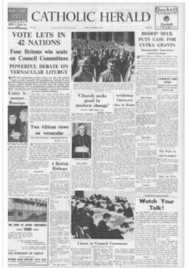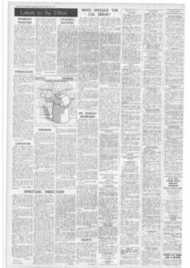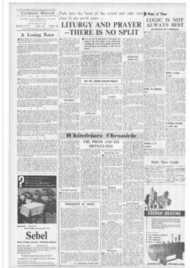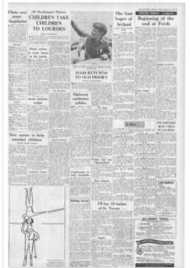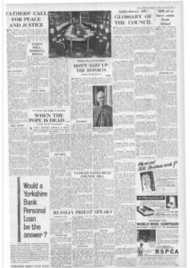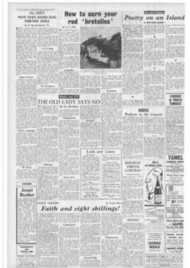Page 4, 26th October 1962
Page 4
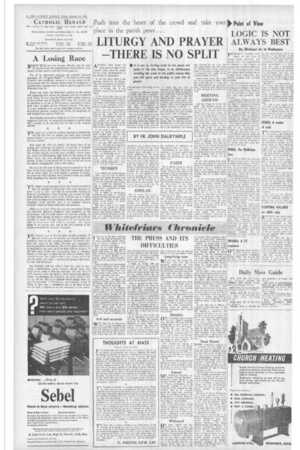
Report an error
Noticed an error on this page?If you've noticed an error in this article please click here to report it.
Tags
Share
Related articles
Fr. Robert A. Graham, S.j., Looks At Saul Friedlander's...
Pope Benedict’s Brief, But Significant First Encounter...
Pipal Prinacy And Episcopal The Bishop In A Universal
Whitetriars
Sisters At The Crossroads
Whitetriars fltrotticie
THE PRESS AND ITS DIFFICULTIES
T AM not in the least surprised I that the Pope should have had En warn journalists against reporting the Vatican Council as they might a political assembly. Nor, on the other hand, am I really surprised that they should have been doing so. The fact Is that the Press relations side of the Council is being hendlcd in a manner which is most unsatisfactory from the journalistic point of view.
I am not referring to the physical facilities—telephone boxes, cable offices, telex machines, etc.—which are the nerve system of the communications world. These are, by general consensus, first rate. But there is more to modern journalism than providing the means of "filing" copy, It first must be written and here is where the Council secretariat is failing. Never before in the Church's history has such an opportunity been presented to it for projecting a proper Image through all the media of mass communication. The world's press and broadcasting services have taken a great and, on the whole, sympathetic interest in the Council. The proof that the Church herself regards these media as important is found in the fact that one of the ten Commissions has been given the task of dealing with them.
Full and accurate
WHY, then, has the Secretariat failed to give journalists the help they need? The reason is that it is still thinking in archaic terms and does not realise that journalists, unless they get the material,
cannot be expected to write full and accurate reports of what the Council is doing, couched in language which will be understood bs readers but will not give offence to the Council Fathers.
I stress the words "full and accurate". For it would be possible to cover the Council cursorily by using only the brief statements which are being handed out each day the Council meets. But the avid public interest in the Council —and surely this is a good thing— will not be satisfied by this alone.
What is required is fuller briefings from officials who know the true significance of events and at the same time understand the workings of newspapers and broadcasting media. From all the reports coming from Rome it appears that the officials charged with catering for the press serve no other function than to provide translations in the different language groups of the brief official statements issued. It is not their fault: they are limited in their task to what they are permitted to do. It is not too late yet for the Council Secretariat to look into this side of things. The arrangements for the World Council of Churches at New Delhi were superb. Granted the limitations imposed on the Vatican by the overriding need for secrecy in the discussions themselves, could there not be some better system of guid log journalists in what tor most of them is an extremely difficult task?
Long-living nuns
wE all know that women live longer than men. But an American statistician, Dr. Con Fecher, Professor of Economies at the (Catholic) University of Drayton, Ohio, has discovered that nuns live longer than other women— three years on average at present and probably four years longer by 1975.
He bases his figures on a study of statistics from 90,000 nuns in 90 societies in the U.S. and comparing them with the national average for "white females". Fifty years ago, a 20-year-old sister had a life expectancy of 45 years. Today. the comparable figure is 59 years. Why the improvement? Mainly, Dr. Fecher found, because of better control of tuberculosis and other communicable diseases which hit hardest an enclosed community like a family or a convent.
Statistics
oNE interesting result emerges from Dr. Fecher's investigations. Between 1905 and 1950, the average age of nuns in the U.S. increased from 17.6 to 45.3 years.
During the same period, the percentage of sisters 45 years of age and older increased from 27.4 to 51, and of sisters over 60 from 7.7 to 21.6. At the same time, the percentage of sisters between 17 and 29 fell from 11.9 to 18.4.
This comparative ageing of religious sisters obviously brings problems in its train. particularly since the trend is continuing. Dr. Fecher forecasts that by 1975 onethird of the members of religious communities for women will be over 60.
Dr. Fecher is visiting Britain and Ireland at present to collect statistics on the reuses of death in nuns. He hopes to prepare similar collated statistics for U.S. nuns.
Interest
4R. HAROLD WILSON, the "Shadow Foreign Secretary". displayed a great interest in the Vatican Council when he visited his Iluyion constituency at the week-end. Talking to the local clergy before the opening of a new Catholic club in St. Aloysius parish, he asked many questions about the possible outcome of the deliberations in Rome. Publicly, he emphasised the importance of the Council to all Christians,
Mr, Wilson also paid a warm tribute to the parish priest, Canon Michael O'Stillisan. who has completed 28 years in charge of the parish. In that time he built a new church, presbytery, three schools and a youth centre, at a total cost of about es00,000
Whitewash
HIS many friends and supporters in this country are feeling somewhat peeved this week with Torn Mboya, Kenya's Labour Minister, who opened the Mau Mau exhibition in Nairobi at the weekend. For that's what it was in effect. We all realise that politics is the art of the possible, and that any African leader today has to roar "Africa for the Africans" to his
own people while pleading moderately for inter-racial partnership in his dealings with the outer world, Indeed, in saying both things openly in the same breath at the weekend, Tom Mboya was being entirely sincere. He hefieves in a truly African Kenya, in which Europeans can be welcomed as fellow citizens and co-operators (he knows full well that Kenya can't cope without them). Ile also has the grander vision of a Kenya taking her proper Place in the shaping of world affairs, and not just her own.
But he ought to be a good deal more discriminating when he starts talking about the glorious past of the freedom fighters (or words to that effect). Be mentions Dadan Kimathi as a hero, and fails to add that Kimathi became a Catholic in prison arid presumably died repenting for his share in the atrocities. Success and the memory of the white man's sins do not whitewash the murder, with foul mutilation, of women and children, African as well as British. or the diabolical motif of the Mau Mau oath.
As one who sees in Mboya potential world statesman of the highest calibre, I am sorry to see him helping to perpetuate the wrong sort of myth. You can't just remember the good arid forget the bad. It is all the more odd as one knows that Tom himself would never have a hand in Mao Mau method. Perhaps the time has come fur him to face openly, what he and some Of his friends must surely know in their inner hearts. that Jomo Kenyatta is an embarrassment. and that a nation built on the Kenyatta legend will not be holy.
lnnes Review" THERE is nothing in England to A compare with the "Innes Review", an historical periodical produced by Catholic scholars, which has contained come of the best work yet carried out on the Scottish Reformation. Writers connected with the "Innes" have been prominent among the many contributors to the "Essays on the Scottish Reformation (1513-1625)", now published by John S. Burns of Glasgow at 70s. The endeavour is a re-assessment of the leading personalities, institutions and events of tha stormy period in the tight of the most tip to date evidence. The resulting picture, it is claimed. is much more credible than the uncomplicated and ingenuous tales of "our grandfathers, whether Protestant or Catholic".
Edited by Fr. David McRoberts. S.T.L., F.S.A., professor of Church history at St. Peters College. Cardross, the book contains 482 pages of text with 20 prefatory pages explaining the illustrations. which themselves run into an aggregate of 58 pages. Members of the staffs of the Scottish universities have lent generous assistance.
Contributors include Dr. J, H. Burns. Reader in Political Thought, London University; three well known Scottish teachers, Mr. Matthew s Mahoney, Dr. Denis McKay and Dr. John Durkan : Dr. Gordon Donaldson, Reader in Scottish History. Edinburgh University: Fr. Maurice 1 aylor. St. Peter's College, Cardross: Fr. W. J. Anderson, Keeper of [he Scottish Catholic Archives: Brother Kenneth, headmaster of St. Mungo's Academy, Glasgow; Dr. Thomas Winning, of the Roman Rota; and Fr. Anthony Ross, 0,15.
blog comments powered by Disqus


